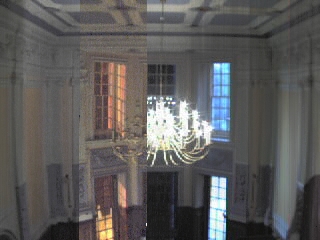The Spectrascope
South Hill Park
home
gallery installation
south hill park
archive
haunted media
publications &press
credits
email
![]()

Above. South Hill Park, Berkshire, England. Interior view.
This image was collected at the rate of a pixel every second via the internet
in vertical bands.
It depicts the 21 hours and 20 mins (approx.) leading up to Sunday 11th
September at 12.21pm
From October 2005, a webcam is transmitting images live from the interior of South Hill Park, a haunted manor house in Bracknell, Berkshire, England.
Now an arts centre, South Hill Park has a varied and often tragic history. Below are some excerpts from web references to its haunted history.
The Haunting of South Hill Park:
1.
South Hill Park is a beautiful red brick mansion constructed at the end
of the 19th century, but incorporating part of an older house of 1760.
It has an infamous reputation as a haunted house. There are constant unexplained
bangings, wailings, rattling of keys, footsteps and cold rushes of air.
Doors that always stick suddenly slam shut, and lock of their own accord,
lights come on by themselves and visitors have a sense that they are being
watched.
The main culprit is thought to be Major Rickman, the building’s
owner, who, having exhaustive debts, shot himself in the gun-room. However,
some witnesses have had the feeling their ghost was that of a playful
child. Others of a middle-aged man on the stairs, unsure of passing by
the living. One explanation has it that the child or children died in
a terrible fire in their nursery in the 1890s, and that the man on the
stairs is the butler or footman who tried to save them. Others say that
the phenomena are connected with a laundry maid was boiled to death during
an accident in the kitchen.
2.
There are many ghosts here. There are children screaming from when they
died in a fire. There is a landing which has been raised a foot, and a
lady ghosts feet now goes into the floor because she walks on the original
landing.
3. A General History of South Hill Park
(note the unfortunate early deaths and shootings)
South Hill Park is an elegant red-brick mansion, mostly of the Victorian
period. It stands within fine gardens and the remnants of its original
800 acre park which still features two good lakes, situate at Birch Hill
in Bracknell.
The first house on the site was built in 1760 for a retired senior official
in Government of Bengal named William Watts. His architect constructed
a fashionable two storey brick Italianate building decorated with stucco
and a Baroque tower. Watts enclosed some 30 acres of common land to add
to the park he was creating and found himself obliged to erect a set of
almshouse near Easthampstead Church as a form of compensation to the locals.
Unfortunately, he died only four years later, and the house began its
journey through a number of new owners.
The Hon. Henry Bouverie was there until 1787, then Sir Stephen Lushington
and George Canning, who acquired the property in about 1801. In this same
year, he engaged Sir John Soane to make alterations at the house in preparation
for the arrival of his new bride. Canning was a Great Statesman, being
Secretary of State for Foreign Affairs under William Pitt and Foreign
Secretary under Lord Portland. In 1809, he was famously wounded in the
thigh during a duel with the Minister for War, Lord Castlereagh, after
an argument concerning troop movements against Napoleon. But he had sold
South Hill Park the previous year and the house did not see its one time
owner appointed as Prime Minister in 1827.
The Earls of Limerick were the next owners of the Park, followed by Sir
James Matheson. In 1853, he sold the estate to the Judge Advocate General,
Sir William Goodenough Hayter. His busy political career had left him
somewhat depressed and he was found drowned in the lake at South Hill
Park in 1878. Towards the end of the century, his son, Sir Arthur Divett
Hayter, rebuilt most of the house following a disastrous fire. Under the
direction of Temple Moore, the building we see today was erected in local
Lawrence brick and Bath stone. The east wing of the original house was,
however, retained within the new structure. The Hayter Coat of Arms, featuring
three golden bulls' heads and a scallop shell can thus be seen over the
main entrance. William Gladstone visited the Hayters at South Hill Park
in 1893 and a plaque in the grounds records that he planted an oak tree
there. Sir Arthur inherited the Haversham Barony in 1906, but he had no
direct heirs and, in 1929, the house passed to his wife's nephew, a Major
Rickman. This man is best known for shooting himself in the Gun Room in
1940.
During the Second World War, South Hill Park was occupied by the Royal
Sea Bathing Hospital, which had been evacuated from Margate. After the
War, it was divided into flats, but was purchased by the BBC in 1953 and
parts were converted into studios and acoustically treated rooms. In 1963,
the Bracknell Development Corporation acquired the house as part of an
extension of the new town's designated coverage. They let South Hill Park
to Ferranti in 1965 and it was used as laboratories and offices until
early 1972 when proposals for its conversion to an Arts Centre and theatre
were agreed. The house is now one of the largest and diverse arts facilities
in the country. It also has a secondary reputation as one of the most
haunted houses in Berkshire.
Web references:
1.http://www.berkshirehistory.com/legends/ghosts_b.html#southhillpark
2. http://theshadowlands.net/places/uk.htm
(A Haunted Places, UK website)
3. http://www.berkshirehistory.com/castles/south_hill_park.html
(a Berkshire History website)
4. http://www.southhillpark.org.uk/aboutUsHistory.jsp
(South Hill Park Art Centre website)
All images © susan collins 2005 -8